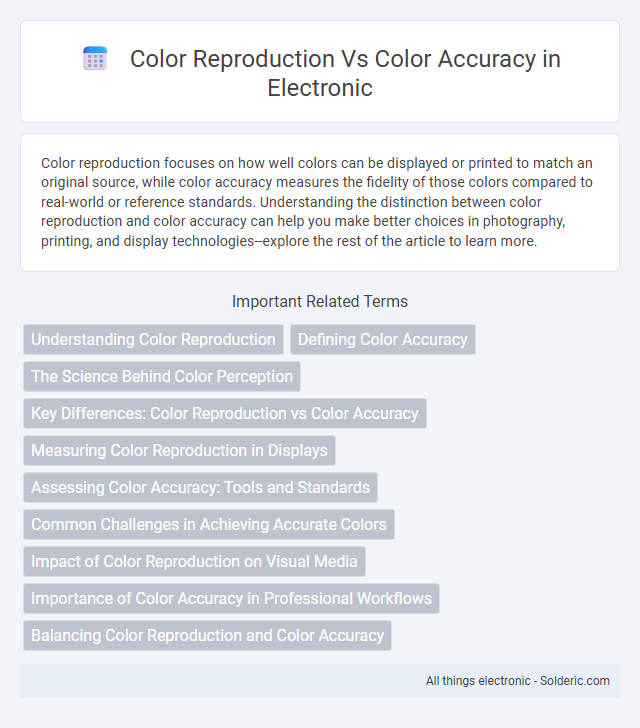Color reproduction focuses on how well colors can be displayed or printed to match an original source, while color accuracy measures the fidelity of those colors compared to real-world or reference standards. Understanding the distinction between color reproduction and color accuracy can help you make better choices in photography, printing, and display technologies--explore the rest of the article to learn more.
Comparison Table
| Aspect | Color Reproduction | Color Accuracy |
|---|---|---|
| Definition | The ability of a device to display or print colors vividly and richly. | The degree to which displayed or printed colors match the original source precisely. |
| Focus | Enhancing color vibrancy and saturation. | Ensuring true-to-life color representation. |
| Measurement | Qualitative, based on color intensity and range. | Quantitative, using tools like Delta E to measure color deviation. |
| Importance | Vital for marketing, design, and media requiring impactful visuals. | Critical for scientific imaging, color grading, and brand consistency. |
| Devices | Monitors, printers, cameras emphasizing vivid display. | Calibrated monitors, spectrophotometers, colorimeters. |
Understanding Color Reproduction
Color reproduction refers to the process of capturing, displaying, or printing colors as close to the original source as possible, emphasizing how devices interpret and render colors across different media. Key factors influencing color reproduction include device calibration, color profiles (such as ICC profiles), and the technology used in cameras, monitors, and printers. Accurate color reproduction ensures consistent visual experiences by minimizing color shifts and distortions throughout the imaging workflow.
Defining Color Accuracy
Color accuracy refers to the degree to which reproduced colors match the original hues intended by the source material or the human eye's perception. It is measured by metrics such as Delta E, which quantifies the difference between expected and displayed colors, ensuring faithful color representation in photography, printing, and digital displays. Your understanding of color accuracy is essential for achieving reliable results in industries where precise color matching impacts visual quality and brand consistency.
The Science Behind Color Perception
Color reproduction involves replicating the exact hues and tones from an original source, while color accuracy measures how closely these reproduced colors match human visual expectations. The science behind color perception centers on the interaction between light wavelengths and cone cells in the human retina, which interpret colors based on three types of photoreceptors sensitive to red, green, and blue. Your ability to discern subtle differences influences how color reproduction techniques are developed to achieve optimal color accuracy across devices and environments.
Key Differences: Color Reproduction vs Color Accuracy
Color reproduction refers to the ability of a device or process to display or print colors as intended, encompassing the range and vibrancy of colors it can produce. Color accuracy measures how closely the reproduced colors match the original source, emphasizing fidelity and precision. Understanding the key differences between color reproduction and color accuracy helps you optimize visual quality in photography, printing, and digital displays.
Measuring Color Reproduction in Displays
Measuring color reproduction in displays involves evaluating the range of colors a device can produce, often quantified by color gamut coverage such as sRGB, Adobe RGB, or DCI-P3. Instruments like spectrophotometers and colorimeters are used to capture precise color output, comparing it against defined color standards. This process ensures the display's capability to reproduce colors vividly and consistently across various content types.
Assessing Color Accuracy: Tools and Standards
Assessing color accuracy involves using specialized tools such as spectrophotometers and colorimeters, which measure color output against standardized color references like the Pantone Matching System (PMS) or the International Commission on Illumination (CIE) standards. These devices evaluate how closely a device's reproduced colors match the original colors, ensuring consistent and reliable color representation across different media. Your ability to maintain color accuracy depends on employing these tools and adhering to industry standards for precise color calibration and quality control.
Common Challenges in Achieving Accurate Colors
Common challenges in achieving accurate colors include device calibration inconsistencies, varying lighting conditions, and differences in color profiles across monitors and printers. Metamerism often leads to color discrepancies when colors match under one light source but not another. You must address these factors through precise calibration tools and standardized color management workflows to improve color reproduction and accuracy.
Impact of Color Reproduction on Visual Media
Color reproduction significantly influences the quality and perception of visual media by ensuring that colors appear vibrant and true to the creator's intent across different devices and platforms. Accurate color reproduction enhances viewer engagement and emotional response by maintaining consistency in hues, saturation, and brightness, which is crucial for branding, marketing, and digital content creation. Your ability to deliver precise color reproduction directly affects how audiences interpret and connect with visual narratives, making it an essential component in photography, film, and graphic design.
Importance of Color Accuracy in Professional Workflows
Color accuracy is critical in professional workflows to ensure that the colors displayed or printed precisely match the intended design, maintaining brand consistency and visual integrity. High color accuracy is essential in industries such as photography, graphic design, and printing, where even slight deviations can impact client satisfaction and product quality. Accurate color reproduction minimizes costly errors and revisions, streamlining the production process and enhancing overall efficiency.
Balancing Color Reproduction and Color Accuracy
Balancing color reproduction and color accuracy involves achieving vibrant, true-to-life hues while maintaining fidelity to the original scene or design. Effective color management systems calibrate devices to ensure consistent output across monitors, printers, and cameras, preventing color shifts and distortions. Advanced technologies like ICC profiles and spectrophotometers enable precise adjustments that optimize both the richness of reproduced colors and the accuracy required for professional imaging and printing workflows.
Color Reproduction vs Color Accuracy Infographic

 solderic.com
solderic.com